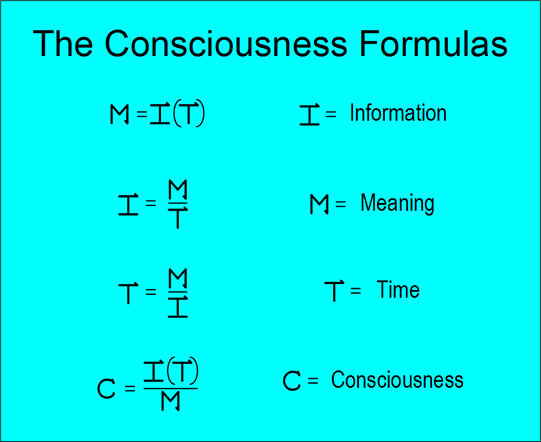|
|
 
the Information Variable("Meaning" divided by "Time")At first glance, the formulas you see above may appear to be an overly simple and reductionist way to represent our minds. After all, there are only four simple variables here. Yet I'm saying three of these variables can represent everything we see, hear, think and do. At least the essence of all these things. Before showing you how though, I need to offer at least a beginning sense of how I've defined these three terms, the three being "information," "meaning," and "time." Let's start with "information." To begin with, "information" as I use this term means everything which actually and potentially informs us we exist, both our inner world and our outer world, the world at large. Surprisingly, we can reduce this down to only two piles of information, our thoughts and our feelings. How do I define these two terms though? Begin with the idea that this information, and we as beings, exist simultaneously in two worlds, in a physical world, and in a non physical world. Of course, the more common way to refer to these two worlds would be to call them the "material" world and the "spiritual" world. Here, I define the Material World (the physical world) as "the place which contains everything we can actually or potentially measure, the place with physical dimensions." I then define the Spiritual World (the non-physical) as "the place that contains everything we can not actually or potentially measure, the place without physical dimensions." Why define these things as two "worlds?" Because by defining them this way, we get to empirically divide what we can know scientifically from what we can never know scientifically but can know only intuitively, the spirit of what we experience. What do we gain from doing this? For one thing, we free ourselves from the ridiculous notion that if it exists we can measure it and if we cannot measure it then it is not real. In the Emergence model of consciousness then, we can measure anything in the physical world but nothing in the non physical world. Further, we as beings exist in both worlds simultaneously and in equal proportions. For a moment now, consider what this would mean if we were to take this assumption as true. For one thing, we would forever free science from the terrible burden to logically define things like love and consciousness. At least from the non physical half of these things. We would also begin to make peace between the two warring camps of science and spirituality. And give credit where credit is due and stop wasting our valuable energies on trying to discredit the other faction. Finally, we would then get to see that all of the information we experience in life can be divided into two types of information, what I call the two languages of these two worlds; thoughts and emotions. Here, I define thoughts as "any mental construct, anything we can think about our experiences." Moreover, from the moment in which people create them, these thoughts exist as actual entities in the material world. As for emotions, I define them as "any non-mental construct, anything we can feel about our experiences, and from the moment in which people create them, emotions exist as actual entities in the spiritual world. Said in other words, thoughts are the language spoken by the "head," and taken to their highest form, they inform us of the logically scientific aspects of life, while emotions are the language spoken by the "heart," and taken to their highest form, they inform us of the spiritual aspects of life. As for how these two languages become the "information" variable, picture a continuum from all thought and no emotion on the left to all emotion and no though on the right. And if this is too abstract, try picturing a kitchen sink where the cold water on the right represents our thoughts and where the hot water on the left represents our emotions. Now consider how everything we think and feel can be seen as some combination of these two ways in which we are informed about what we are experiencing. As for why I've chosen to reverse the normal right and left here, I've done this by picturing us as the "sinks," meaning that the left and right sides would be defined as if we were standing behind the faucets and not from in front of them. Finally, for those who learn best visually, I offer the following diagrams. As you can see, there are two information "faucets," a "mental" information faucet on the left, and an "emotional" information faucet on the right. Together, these two languages comprise the entirety of what actually and potentially informs us that we exist. As a term then, I call this entirety, the Information Variable.
This Information is "All Thoughts"
This Information is "All Emotions"
This Information is "Equal Parts Thought and Emotion "
 |
|
|
.